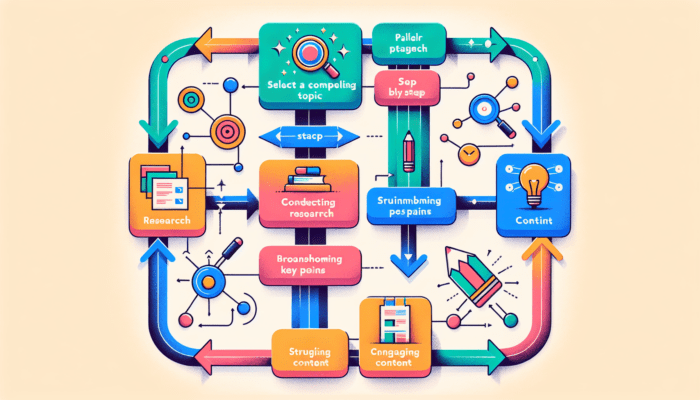Listen to The Asymmetric Marketing Podcast's overview of this article
A pillar page is a comprehensive guide that covers a broad topic and links to detailed subtopics. It enhances SEO and user experience by improving content organization and navigation. This article will help you understand, create, and optimize pillar pages.
Key Takeaways
- Pillar pages act as centralized hubs for comprehensive topics, enhancing user navigation and improving SEO through effective site structure.
- Using topic clusters around pillar pages establishes coherent keyword strategies, enhances search engine comprehension, and builds topical authority.
- Promoting pillar pages through social media, email marketing, and paid advertising is essential for driving traffic and maximizing visibility.
Understanding Pillar Pages

Pillar pages serve as comprehensive overviews of a primary topic, connecting readers to detailed articles on subtopics. They act as centralized hubs of related content, organizing information effectively and enhancing website structure. This improves user navigation and makes it easier for search engines to crawl and index your site, boosting your SEO.
Pillar pages address a wide array of user questions, offering valuable and engaging content that attracts potential customers and enhances user experience. This makes them a comprehensive pillar page and sets a foundation for other pages.
Defining Topic Clusters
Topic clusters are groups of related articles or blog posts that comprehensively understand a broad topic. The topic cluster model enhances search engine understanding of content relationships by grouping related content around a central pillar page. Creating topic clusters requires defining core topics, conducting content audits, and organizing content efficiently. This method enhances user navigation and aids search engines in identifying and prioritizing key pages.
Topic clusters facilitate a coherent keyword strategy that aligns with search engine content interpretation. Internal links between the pillar page and cluster pages form a cohesive content network, improving user navigation and search engine comprehension.
Types of Pillar Pages
Pillar pages come in various forms, each serving unique purposes. The 10x content pillar page aims to surpass competitors by providing superior, in-depth content enriched with infographics and embedded media. This type of pillar page is designed to be ten times better than the best content available on the same topic.
Resource pillar pages are central hubs linking to multiple resources, such as articles, tools, and external references related to a specific topic. These pages offer valuable tools and learning resources while attracting backlinks and boosting the site’s authority and SEO.
How-to pillar pages offer comprehensive step-by-step instructions on completing specific tasks. These pages break down broader processes into manageable steps, offering detailed guidance and practical insights—valuable for users looking to learn new skills or complete complex tasks.
SEO Benefits of Pillar Pages

Pillar pages offer numerous SEO benefits, including improved site structure, effective keyword targeting, and enhanced topical authority. A well-organized framework in pillar pages facilitates easier crawling and indexing by search engines.
They also allow for efficient keyword targeting, with primary keywords used for pillar pages and long-tail keywords for cluster pages. Ultimately, comprehensive pillar pages build trust with searchers and establish your expertise, boosting your topical authority and search engine rankings.
Improved Site Structure
Search engines favor content organized by topics over those organized solely by keywords. Pillar pages improve site navigation by grouping related website pages, making it easier for users to find information. Linking all cluster pages to the pillar page and vice versa forms a cohesive content network, improving user navigation and search engine comprehension. This strategy is often referred to as pillar and cluster pages.
Pillar pages often act as central destinations, frequently linked from the homepage, helping visitors quickly find comprehensive information on a topic. This improved user experience helps visitors find information more quickly and efficiently, leading to better engagement and higher search engine rankings.
Targeting Keywords
Pillar pages should focus on broad, high-volume keywords to capture a wide audience. These keywords are essential for the main topic of the pillar page and should have a high search volume and manageable keyword difficulty. Including the primary keyword in the title of the pillar page is crucial for SEO.
Cluster pages, on the other hand, dive into more specific, long-tail keywords to capture detailed queries. Combining broad and long-tail keywords within a topic cluster provides comprehensive coverage and enhances the site’s overall keyword strategy.
Building Topical Authority
Thorough topic coverage in pillar pages helps establish site authority, increasing the likelihood of higher search engine rankings. Comprehensive topic coverage engages users and signals to search engines that your site is an authoritative source on the subject.
This enhanced topical authority can improve SEO rankings and increase organic traffic.
Creating a Pillar Page: Step-by-Step Guide

Creating a pillar page involves critical steps such as choosing a core topic, conducting keyword research, and structuring your content to create a pillar page. This guide ensures your pillar page is comprehensive, engaging, and effective for SEO and user experience.
Choosing a Core Topic
The first step in creating a pillar page is selecting a core topic. The chosen topic should align with your audience’s interests and have the potential for multiple related subtopics. When brainstorming ideas for pillar pages, consider core topics relevant to your website and audience.
Before creating a pillar page, answer specific questions to ensure the topic’s suitability. Concentrating on one subject at a time avoids confusion and prevents diluting your efforts.
Tools like Topic Research can generate ideas for subtopics related to your core topic.
Conducting Keyword Research
Effective keyword research identifies keywords matching the pillar and cluster page topics, focusing on user intent. After generating an idea for your pillar page topic, use a keyword research tool to find relevant keywords.
This ensures that your content will rank well in search engine results and attract the right audience.
Structuring Your Content
A pillar page outline should include all cluster page subtopics to ensure comprehensive coverage and logical flow. User intent must be considered to optimize content layout and meet reader expectations.
A user-friendly pillar page layout includes clear sections, headings, bullet points, short paragraphs, relevant images, and a table of contents. Incorporating visuals and avoiding text-only articles significantly enhance readability on pillar pages.
Internal linking should connect each cluster page subtopic to the pillar page to enhance topical relevance. After the initial outline, review and tweak it for optimal structure and flow.
Writing High-Quality Pillar Content
High-quality pillar content must be comprehensive, engaging, and relevant to the target audience. This section covers content strategy for crafting compelling headlines, using visuals and media, and ensuring readability to enhance user engagement and improve SEO performance.
Crafting Engaging Headlines
To attract readers effectively, headlines should be compelling and reflect the primary focus of the pillar content. Incentives such as exclusive content can encourage subscribers to click through to your pillar page.
Engaging headlines are crucial for drawing readers in and making a solid first impression.
Using Visuals and Media
Using visuals like images and infographics significantly enhances user engagement and comprehension. Visuals enhance user experience by making content more accessible and engaging. Videos can be powerful tools to illustrate complex ideas within pillar pages, improving user retention.
Combining images and videos creates a rich multimedia experience, enhancing overall engagement. Making content visually appealing and easier to understand keeps readers interested and encourages more extended page visits.
Ensuring Readability
Break up text with visual elements instead of presenting large blocks to improve clarity. Formatting techniques like using bullet points can also make information more digestible and encourage reader engagement.
Readability is key to maintaining user interest and improving the overall effectiveness of your pillar page.
Promoting Your Pillar Page

Promoting your pillar page drives traffic and increases visibility. This section covers strategies for leveraging social media, email marketing, and paid advertising to reach a broader audience and achieve its full potential.
Leveraging Social Media
Social media platforms are pivotal in promoting your pillar page and increasing its visibility. Guest posting on other websites is an effective short-term promotion strategy.
Sharing your pillar page on social media engages your target audience and drives traffic to your site.
Utilizing Email Marketing
Email campaigns can effectively share your pillar page by including links and summaries in newsletters. Email marketing shares your pillar page with subscribers, encouraging visits and engagement.
Encouraging subscribers to share the pillar page expands its reach and improves visibility.
Paid Advertising
Paid ads target specific demographics to maximize reach for your pillar page. Retargeting ads re-engage visitors who previously viewed your pillar page. Paid advertising drives targeted traffic to your pillar page, using platforms like Google Ads to boost visibility and reach specific audiences.
Measuring the Success of Pillar Pages

Measuring the success of your pillar pages evaluates their effectiveness and identifies necessary improvements. This section covers key metrics to monitor, tools for analysis, and the importance of continuous improvement to keep your pillar pages relevant and effective.
Key Metrics to Monitor
Great pillar pages rank well, attract traffic, and generate total clicks from Google Search Console as a primary indicator of SEO success. Monitoring key metrics like average engagement time and the number of keywords your pillar page ranks for is crucial for evaluating its success in search engine results.
Tools for Analysis
Recommended tools for tracking pillar page performance include Google Search Console and Google Analytics. Google Analytics provides insights into user behavior, including traffic sources and engagement rates. These tools enable effective monitoring and analysis of pillar page performance.
Monitoring indexed pages in Google Search Console ensures key content is discoverable. These tools provide a comprehensive overview of your pillar page’s performance and identify areas for improvement.
Continuous Improvement
Regularly updating pillar pages based on performance data maintains their relevance and effectiveness. Revisiting your pillar page quarterly and making necessary updates enhances its effectiveness and ensures it meets traffic and engagement goals.
Summary
Summarize the key points discussed in the blog post, highlighting the importance of creating effective pillar pages for improving SEO and user engagement. End with an inspiring phrase encouraging readers to implement these strategies and continuously improve their content marketing efforts.

Frequently Asked Questions
What is a pillar page?
A pillar page is a centralized hub that offers a comprehensive overview of a main topic while linking to detailed articles on related subtopics. This structure enhances navigation and improves content organization for readers.
How do topic clusters improve SEO?
Topic clusters enhance SEO by structuring content around a central pillar page, which helps search engines better understand content relationships and boosts keyword strategy effectiveness. This organization not only improves discoverability but also encourages higher user engagement.
What types of pillar pages exist?
Pillar pages can be categorized into 10x content pages, resource pillar pages, and how-to guides. Each is designed to meet specific user requirements and enhance content engagement. Selecting the right type depends on your audience's needs and content strategy.
How can visuals and media enhance pillar pages?
Incorporating visuals and media like images, infographics, and videos can significantly enhance user engagement and comprehension on pillar pages, making the content more accessible and appealing. This integration helps to keep readers interested and facilitates a better understanding of complex information.
What tools can I use to measure the success of my pillar pages?
To effectively measure the success of your pillar pages, utilize tools such as Google Search Console and Google Analytics. These tools offer valuable insights into user behavior, traffic sources, and engagement rates, helping you assess performance accurately.
How can I choose the best topics for my pillar pages?
When selecting a topic, focus on areas where your business offers the most expertise or value. The topic should be broad enough to encompass various subtopics but specific enough to be relevant to your audience. When deciding, consider customer pain points, common questions, and SEO potential.
What metrics should I track to measure the success of a pillar page?
Key performance indicators (KPIs) include organic traffic, dwell time, bounce rate, and the number of backlinks. Tracking conversions from the pillar page to related service or product pages can give insight into its effectiveness as part of your sales funnel.
Can I update my pillar pages over time?
Yes, pillar pages should be updated regularly. As your industry evolves, so should your content. Refresh your pillar pages with new data, industry trends, and additional subtopics to maintain their relevance and SEO value.

Listen to The Asymmetric Marketing Podcast's overview of this article
About the author
Mark A. Hope is the co-founder and Partner at Asymmetric Marketing, an innovative agency dedicated to creating high-performance sales and marketing systems, campaigns, processes, and strategies tailored for small businesses. With extensive experience spanning various industries, Asymmetric Marketing excels in delivering customized solutions that drive growth and success. If you’re looking to implement the strategies discussed in this article or need expert guidance on enhancing your marketing efforts, Mark is here to help. Contact him at 608-410-4450 or via email at mark.hope@asymmetric.pro.

